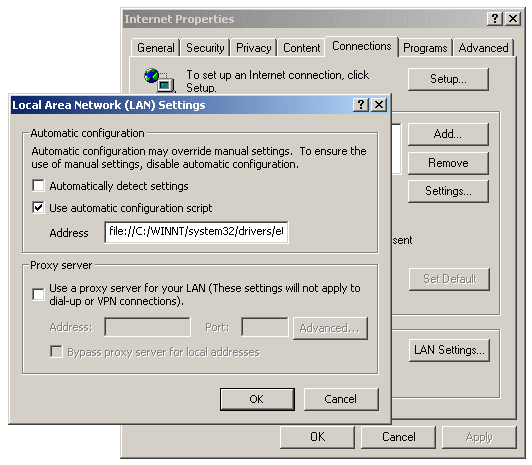Pac File Browser Configuration
What Color is Your Parachute? Has been Ten Speed's best-selling book for nearly three decades, and it continues to be the job-hunter's bible—even in times of a strong, robust economy, when conventional. Side note: Over twenty years ago, I saw What Color is Your Parachute in my college library. I thought to myself what a stupid name. Now I wished I would have picked up the book them. It would have save me so much time and money. What color is your parachute 2012 epub converter. Desi Sex Videos Free Indian Sex Videos Indian Sex Stories India 1st time hottest anal/. Download what-color-is-your-parachute-or read what-color-is-your-parachute-online books in PDF, EPUB and Mobi Format. Click Download or Read Online button to get what-color-is-your-parachute-book now. This site is like a library, Use search box in the widget to get ebook that you want. Release Date: 2012.
A Proxy Auto-Configuration (PAC) file is a set of instructions, coded in JavaScript, that determines whether web browser requests go directly to their desired. Select Connection, then double-click Automatic Browser Configuration in the right pane. On the Automatic Configuration tab: Select Automatically detect configuration settings and Enable Automatic Configuration. Enter an interval in the Automatically configure every checkbox. Enter your PAC URL in the Auto-proxy URL box.
File Explorer

Are you deploying browser proxy settings by setting a proxy server and attempting to manage a proxy bypass list? There is a better way.
Fortunately Jason Curnow, who’s had many years experience working with PAC files, has a website where he’s documented his experiences and shows you how to create your own - The Proxy PAC File Guide.
Any proxy server or firewall (a firewall is going to understand the network topology better than a proxy server) worth it’s salt will do this type of work for you. I know my favourite firewall, ISA Server does - Automatic Detection Concepts in ISA Server 2006 (I’m sure other proxy servers or firewalls do too).
In complex environments you may not be able to rely on your proxy server to handle browser configurations completely, so you’ll need to roll up your sleeves and roll your own PAC file.
Or use it to create really cool photo slideshows - with 2D and 3D transitions, animation, and your choice of music - that you can share with your Facebook friends or Google+ circles. That's all free as well! Or use it to upload your own PowerPoint slides so you can share them with your teachers, class, students, bosses, employees, customers, potential investors or the world. For a small fee you can get the industry's best online privacy or publicly promote your presentations and slide shows with top rankings. Reserve health readiness program pharmec.
So why a PAC file? Here’s a couple of scenarios that demonstrate the awesomeness of a PAC file:
- Laptop users don’t need to disable their proxy settings when they’re outside the corporate network (OK, the ISA Server firewall client can do this too); and
- If you have internal web applications hosted across WAN links (e.g. your users are in London but SAP is hosted in Ireland), you can use a PAC file to direct specific URLs to proxy servers that handle that SAP traffic only, whilst every thing else goes via your Internet proxy.
So go and check it out, Jason has done some excellent work - The Proxy PAC File Guide.
Other Resources
If you want the clients to connect using an automatic configuration script to connect to your proxy server, which will work if it is accessible, and won’t work from else where, e.g. laptop users at home. If the location (http://pac/proxy.pac) can’t be reached, IE will skip over the script and go direct out to the internet.
To setup your proxy .pac file on a Windows Server 2008 server.
- Create your proxy.pac file (follow the examples below)
- Copy your .pac file to (C:inetpubpac) of your IIS server which will host the .pac file
- In IIS, right click on sites, choose Add Web Site
- Fill in the details as below. Under bindings, the host name is what the site will respond to, for example (http://pac/proxy.pac) if you wanted to use a fully qualified DNS name, e.g. http://pac.domain.local/proxy.pac then after you add this site, edit the bindings of the website to add this second binding.
- Next thing you need to do is edit the MIME types.
- Add in a custom MIME type for the .pac file extention – application/x-ns-proxy-autoconfig
- You will need to setup a DNS CNAME record so that the hostname pac.domain.local will point to your IIS server.
- Last thing you will need to do is setup a group policy for all your users to enforce these settings.



